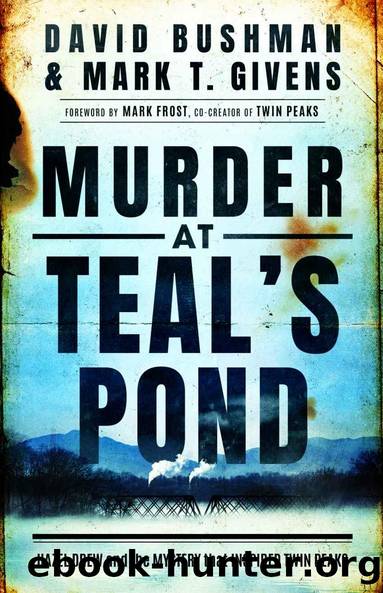Murder at Teal's Pond: Hazel Drew and the Mystery That Inspired Twin Peaks by David Bushman & Mark T. Givens

Author:David Bushman & Mark T. Givens [Bushman, David & Givens, Mark T.]
Language: eng
Format: epub
Publisher: Thomas & Mercer
Published: 2022-01-01T05:00:00+00:00
Like nearly everything in Troy, the Mamie Killion murder probe stank of politics. The anonymous citizen who had donated twenty-five hundred dollars to the reward was revealed to be Edward Murphy Jr., who had never been particularly renowned for his bleeding heart. But he was famous for other things. Murphy was a deep-pocketed Troy brewer who, by most accounts, was as crooked as a country lane. He had served as mayor of Troy, a United States senator, and chairman of the New York State Democratic Committee. Those were official titles. His unofficial title was âBoss Murphy,â on account of the fact that he lorded over Upstate New Yorkâs Democratic machine.
In an example of the ever-shifting political coalitions and factions recurring in Troy politics during this era, Mayor Conway, though a Democrat, had broken with Murphy and won election promising reform, coalescing with a group of independent Democrats and progressive Republicans. Boss Murphy wasnât very happy about that. What better way to pay the turncoat back than by implicating one of his cronies in the murder of Mamie Killion?
During the inquest, it was determined that Mamie had visited her friend Annie Calt at about 5:00 p.m. on September 4, accompanied by another friend, Mary Glynn, a forewoman in the collar-starching department at Tim & Co. who, at thirty-two, was considerably older than Mamie Killion. Annieâs husband, Martin J. Calt, was a liquor salesman and a former city alderman with political ties to city hall, a fact that wasnât lost on the newspapers, which played up the connectionâclearly suggesting that Mamie and Martin Calt were more than just friends. Calt acknowledged having met Mamie about a year earlier through his wife but said he had never been anywhere alone with her and called the rumors absurd. Still, they persisted.
The three women dined together the night of September 4. Martin Calt arrived home at 7:40, left again, and returned at about 8:00 p.m. with bottles of lager and sarsaparilla, which he and the women proceeded to share; Mamie had a glass of each. At approximately 8:40, she and Mary Glynn departed.
âWell, you can get on the car and ride, but Iâm going to walk,â Mamie told her friend.
Mary Glynn jumped aboard the trolley car and Mamie bid her farewell for the night, referring to her by her nickname.
âGoodnight, Googey,â she said. âWill see you in the morning.â And that was the last Mary Glynn ever saw of her friend.
Why didnât Mary Glynn walk with Mamie?
âWhy, I had new shoes on, and they hurt!â
But later she confided to her mother that Mamie had acted as if she was going somewhere other than home, intimating that she didnât want Mary to tag along.
Mrs. Calt said she retired for the night at nine thirty. No one else came to the house. Neither she nor her husband left until the following morning. Mrs. Landrigran, who shared their house at 589 River Street, confirmed that account.
âI know he didnât go out that night, for I would have heard him,â Landrigran said.
Download
This site does not store any files on its server. We only index and link to content provided by other sites. Please contact the content providers to delete copyright contents if any and email us, we'll remove relevant links or contents immediately.
Harry Potter and the Goblet Of Fire by J.K. Rowling(3045)
Unfinished: A Memoir by Priyanka Chopra Jonas(2916)
Never by Ken Follett(2880)
The Man Who Died Twice by Richard Osman(2298)
Machine Learning at Scale with H2O by Gregory Keys | David Whiting(2290)
Fairy Tale by Stephen King(2069)
Will by Will Smith(2041)
Rationality by Steven Pinker(1765)
The Storyteller by Dave Grohl(1660)
The Dawn of Everything: A New History of Humanity by David Graeber & David Wengrow(1570)
The Dark Hours by Michael Connelly(1569)
The Stranger in the Lifeboat by Mitch Albom(1532)
Cloud Cuckoo Land by Anthony Doerr(1434)
The Becoming by Nora Roberts(1330)
Friends, Lovers, and the Big Terrible Thing by Matthew Perry(1327)
New Morning Mercies: A Daily Gospel Devotional by Paul David Tripp(1323)
Einstein: His Life and Universe by Walter Isaacson(1315)
Crying in H Mart by Michelle Zauner(1315)
A Short History of War by Jeremy Black(1300)
